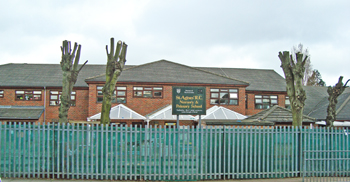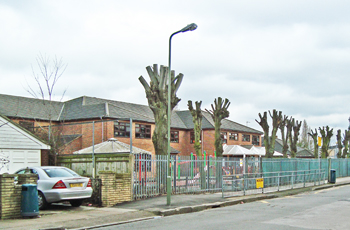Convalescent
In 1885 a small house had been leased on behalf of Princess Christian for use as a Home of Rest for young unmarried mothers convalescing after the birth of their babies. The Home remained open for six years until unavoidable circumstances forced it to close (although four beds were reserved for the girls in a Home at the seaside).
At a meeting held at Grosvenor House in 1894, Princess Christian was determined to establish a more permanent home, and a small committee was formed. St Helena's Hospital Home opened in May the following year in a house in Clapham, with the first mother and baby being admitted on 10th June 1895.
After four years Princess Christian decided that an ordinary house did not fulfill the requirements of a convalescent home. Therefore, a piece of land near Child's Hill was leased for 999 years from the Ecclesiastical Commissioners on which to build suitable premises. A generous gift of £2,600 from Sir Thomas Lipton enabled the new Home to be built and equipped.
The new St Helena's Hospital Home and House of Rest opened in 1907, under the control of the London Diocesan Council for Preventive, Rescue and Penitentiary Work. It had 11 beds and 11 cots. The mothers were usually referred from a lying-in or general hospital, where they had spent between 8 and 14 days after delivery of their babies, or from Rescue workers in the Diocese. At St Helena's they were taught to look after their babies, and encouraged to keep and provide for them. Most stayed (with or without their babies) at least three weeks, but some up to six or seven months, or even longer. On discharge from the Home, the girls returned to work, or to their former situations, to their relatives, or to a hospital, infirmary or hostel.
On average, some 80 mothers and 55 babies were admitted each year (1914 was exceptional, when 133 mothers and 82 babies were accommodated). The Home had a chapel, where many of the babies were baptised by the local vicar. Sometimes, if a baby was sickly, she remained at the Home until her health improved, while her mother was discharged. The mothers remembered the kindness shown to them and would often visit the Home, sometimes even donating funds to the cause.
The Home, with its large garden and kitchen garden, managed to pay its running costs during WW1, despite the rising cost of living. In January 1918 it was forced to close because of a whooping cough epidemic and, in November, new cases were not admitted because of the Spanish flu epidemic (only 67 mothers and 59 babies were accommodated in 1918). In 1919 the Home closed again, from 15th August until 15th October, for work to be done on the drainage.
By 1937 it had been renamed St Helena's Convalescent Home, still administered by the London Diocesan Council, which had renamed itself the London Diocesan Association for Moral Welfare. Its President was Princess Marie-Louise, in place of Princess Christian who had died in 1923. In October and November 1937 the Home was closed for internal redecoration.
On average, during the 1930s, 136 girls and 132 babies were admitted. The Home charged 12s 6d (62p) a week for London cases and 15s (75p) for those from other Diocese.
By 1945 the Home had 12 beds and 12 cots. Patients from the London Diocese were charged 15s (55p) a week, those from the LCC 18s (80p) and those from outside London £1 (twins were 5s (25p) extra).
The Home had to close temporarily in 1945 when Matron was on sick leave and it proved impossible to find a temporary replacement. The Home closed again because of the danger of flying bombs. The mothers and babies were evacuated, while the staff took a 3-week holiday. Only 86 mothers and 85 babies were admitted that year.
In 1946 charges for cases from the London Diocese were increased to 18s (90p) a week, while those from the LCC, MCC and all other areas were charged £1. It was hoped to build a modern nursery for the babies, but post-war shortages of labour and material delayed the project.
By 1948 National Assistance Board cases were being charged 21s (£1.05) and 7s 6d (37p) for the baby; National Health Insurance cases were charged 30s (£1.50) for mother and baby. As the Home was now being underused, a charge was also levied if bookings were not honoured.
The Home did not join the NHS, but closed in 1949.
In 1951, following an agreement with the Board of Governors of the Hammersmith Hospital, the Home was purchased by King Edward' Hospital Fund for £9,500, who converted and leased it to the Hospital as a convalescent home for its patients. St Helena's Recovery Home, with 22 beds, accommodated those who no longer needed treatment in an acute ward, but required some medical or nursing supervision, and possibly out-patient treatment. Patients from the Hammersmith Hospital stayed at the Home until well enough to return home or go to a hostel.
The Home admitted both male and female patients (although there was no male toilet facilities; men had to use the nurses' WC). The nursing staff consisted of 3 nurses, 2 nursing orderlies and one night nurse. In 1954 the cost of an in-patient at the Home was £4 16s 8d (£4.83).
Conditions at the Home were somewhat unsatisfactory but, with the founding of the Friends of St Helena's in 1956, began to improve. The dining room, which also doubled as the lounge, was 21 ft (6.5 metres) and 17 ft (5.2 metres) in size and had to be shared by all 22 patients. The Friends financed an extension to the lounge, furnished it and equipped it with a TV, at a cost of £400. The lounge was officially opened in 1958 by Col. W. Parkes, a member of the Board of Governors of the Hammersmith Hospital and President of the Friends of St Helena's, at the second Annual General Meeting.
The Friends visited the patients, and provided presents for patients and staff at Christmas, and Easter eggs at Easter. A pay-phone was made available for the patients.
In May 1961 the Friends built a summerhouse in the garden for £550, where patients could sit. It also housed the Physiotherapy and Occupational Therapy Departments. In 1963 the summerhouse was connected to the lounge extension by a covered walkway at a cost of £170. Geriatric chairs were also provided for both buildings and, in the wards, tracks were fitted for cubicle curtains to provide more privacy for the patients. A garage was built in the grounds for use by the Sister in charge.
In 1970 the Friends of Hammersmith Hospital donated £2,500 so that the nurses' dining room could be converted into bathroms for the patients. A prefabricated dining room was built for the nurses. The enlarged space enabled more cardiac patients from the Hammersmith Hospital to be admitted. A concrete path was laid around the garden where the more ambulant patients could stroll. A garden seat was provided in memory of Mrs Edith Hailstone.
The Home closed in 1976, a victim of the NHS hospital review during the 1970s.
Present status (March 2009)
The site is now occupied by St Agnes Catholic Primary School, which opened in 1992.

St Agnes School (above and below).

Church of England 1897 The Official Year-book of the Church of England. London, Society for Promoting Christian Knowledge.
http://paperspast.natlib.govt.nz
www.yourdemocracy.newstateman.com
Return to home page